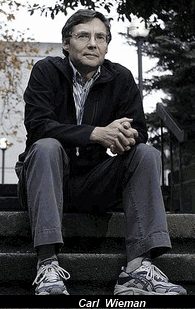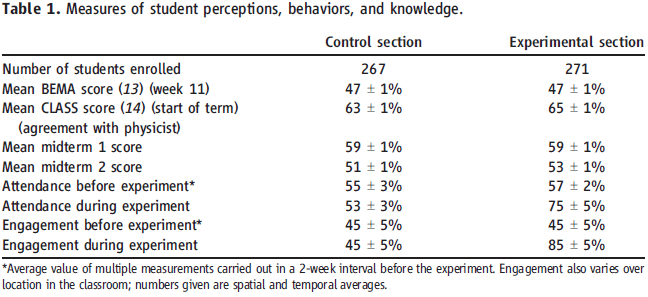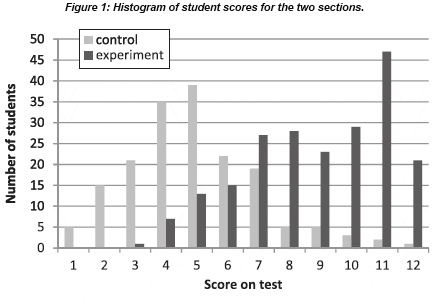
|
|
|
|
|
|
|
News & Views item - May 2011 |
![]() Innovation in Teaching Physics to Large Classes. (May 15, 2011)
Innovation in Teaching Physics to Large Classes. (May 15, 2011)
In 2001 Carl Wieman was awarded, together with Eric Cornell and Wolfgang Ketterle, the Nobel Prize in Physics for the production in 1995 of the first true Bose–Einstein condensate.
Among his other interests, Professor Wieman foundered PhET at the University of Colorado, which contains an extensive set of interactive simulations to improve teaching methods in maths and the sciences. For a number of years now he has championed new methods for the improvement of science education. His prestige as a Nobel Laureate together with his proactive interest in the teaching of maths and science led US President Barack Obama to invite him to become an Associate Director of Science in The White House's Office of Science and Technology Policy. On September 16, 2010 Professor Wieman was confirmed by unanimous consent of the US Senate.
Now in a paper published last week in the journal Science he together with a postdoc and graduate student, Louis Deslauriers and Ellen Schelew report on "Improved Learning in a Large-Enrollment Physics Class". Over 260 students in each a control and experimental group in the second term of a first year physics course at the University of British Columbia took part in the experiment.
The authors' abstract reads:
We compared the amounts of learning achieved using two different instructional approaches under controlled conditions. We measured the learning of a specific set of topics and objectives when taught by 3 hours of traditional lecture given by an experienced highly rated instructor and 3 hours of instruction given by a trained but inexperienced instructor using instruction based on research in cognitive psychology and physics education. The comparison was made between two large sections (N = 267 and N = 271) of an introductory undergraduate physics course. We found increased student attendance, higher engagement, and more than twice the learning in the section taught using research-based instruction.
They compared "learning produced by two contrasting instructional methods in a large-enrollment science course. The control group was lectured by a motivated faculty member with high student evaluations and many years of experience teaching this course. The experimental group was taught by a postdoctoral fellow using instruction based on research on learning. The same selected learning objectives were covered by both instructors in a 1-week period". The experimental group was exposed to "a series of challenging questions and tasks that require[d] the students to practice physicist-like reasoning and problem solving during class time while provided with frequent feedback... the students spent all their time in class engaged in deliberate practice at 'thinking scientifically' in the form of making and testing predictions and arguments about the relevant topics, solving problems, and critiquing their own reasoning and that of others".
The results are shown in their table 1:

The differences of the two groups shown in the third to last and last rows of the table are striking, and the authors feel it is noteworthy that: "In contrast to instructor A, the teaching experience of L.D. and E.S. had been limited to serving as teaching assistants. L.D. was a postdoctoral researcher working in the Carl Wieman (third author of this paper) Science Education Initiative (CWSEI) and had received training in physics education and learning research and methods of effective pedagogy while assisting with the teaching of six courses. E.S. had a typical physics graduate student background except for having taken a seminar course in physics education."
With the end of the 3-hour unit a 12 question test was given to the two groups. The authors write:
The test was administered in both sections in the first class after the completion of the 3-hour unit. The control section had covered the material related to all 12 of the questions on the test. The experimental section covered only 11 of the 12 questions in the allotted time. Two days before the test was given, the students in both sections were reminded of the test and given links to the postings of all the material used in the experimental section: the preclass reading assignments and quizzes; the clicker questions; and the group tasks, along with answers to all of these. The students were encouraged by e-mail and in class to try their best on the test and were told that it would be good practice for the final exam, but their performance on the test did not affect their course grade. Few students in either section finished in less than 15 min, with the average being about 20 min.

Again the differences are remarkable.
Nevertheless, several criticisms have been levelled at the study by psychologists. Daniel Willingham, a psychology professor at the University of Virginia told The New York Times: "The whole issue of how to draw on basic science and apply it in classrooms is a whole lot more complicated than they’re letting on," and went on to say that among other concerns, the study was not controlled enough to tell which of the changes in teaching might have accounted for the difference in students’ scores.
James W. Stigler, a professor of psychology at the University of California, Los Angeles, in an e-mail to the NYT said it was problematic for authors of a study to also be delivering the intervention — in this case, as enthusiastic teachers. “This is not a good idea, since they know exactly what the hypotheses are that guide the study, and, more importantly, exactly what the measures are that will be used to evaluate the effects, they might, therefore, be tailoring their instruction to the assessment — i.e., teaching to the test.”
Professor Wieman wasn't having a bar of it and told the Times that he strongly doubted that the new instructors had this kind of effect on the students. As a rule, he said in an e-mail, students in such large classes “are remarkably removed from any sense of personal connection with the instructor. That does change with a more interactive class, but not enough and not fast enough to have any significant impact on learning in a week.”
And despite his criticisms Professor Stigler made the point: "I think that the authors are pioneers in exploring and testing ways we can improve undergraduate teaching and learning. As a psychologist, I’m ashamed that it is physicists who are leading this effort, and not learning scientists."
In addition to the 2˝ page report the authors have provided 26-pages of supporting material online. For the field of science learning, and not only at the tertiary level, to trivialise the findings of Professor Wieman and his colleagues would be a gross disservice to STEM education.